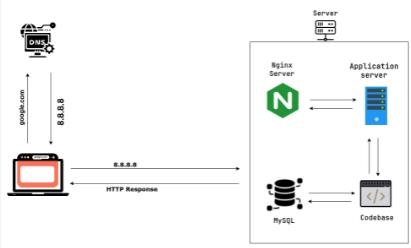When you input “google.com” and hit Enter, a very rapid and complicated digital procedure happens that brings you to your webpage in a matter of milliseconds. This process does DNS lookups, TLS handshakes, and grabs from Content Delivery Networks (CDNs). This smooth trip is a good example of how modern internet technologies function together in the background.
**DNS: Quick Address Translation**
DNS is like a phone book for the Internet that works incredibly quickly. It turns friendly domain names like *google.com* into IP addresses that computers can understand, like 142.251.46.238. To speed things up, your browser first looks in its cache. If there isn’t a cached record, it asks your ISP’s recursive DNS resolver to execute a tiered global search, starting with root servers and going all the way down to Google’s authoritative name servers. This hierarchical lookup is surprisingly quick and dependable; it usually only takes 20 to 120 milliseconds to conclude.
**TLS: Making a Safe Digital Envelope**
Once your device has the IP address, it doesn’t just send data; it also starts a very fast TLS handshake to keep the transfer safe in a way that most people don’t notice. This method uses cryptographic certificates to show who Google is and creates keys to keep your information private in less than a second. This TLS layer stops anyone from eavesdropping on or altering any data that is sent or received. It is very safe to use, whether you are looking for simple information or sharing private information.
**CDNs: The Global Delivery Network That Goes Fast**
But it’s not the only factor that matters when it comes to safety and speed. Content Delivery Networks (CDNs) are servers that store data all around the world, close to where users are. These networks transfer a lot of data from Google. Your request doesn’t go to a central server that is far away. Instead, it goes to a nearby edge node. This greatly reduces latency and guarantees that content is sent promptly and reliably. This design smartly divides the job, which makes it more trustworthy. It works like a bunch of digital messengers that are spread out all over the planet.
**Technologies Working Together in a Dance**
This designed interaction makes it easy to look around:
– DNS quickly detects server IPs, so you don’t have to guess.
– TLS protects every byte, which protects privacy.
– CDNs speed up delivery by putting content on servers that are in the right places.
DNS over TLS (DoT) and DNS over HTTPS (DoH) are two very new ways to encrypt DNS requests directly. This makes things a lot more private and stops whole lookup chains from being watched or stopped.
**In the Future: Smarter, Faster, and Safer**
As internet protocols get better, AI-powered innovations should make DNS resolution faster and CDN routing more flexible. This will aid billions of users all over the world. New protocols like HTTP/3 and encrypted DNS systems promise to make speed and privacy even better. This will be the beginning of a period when the digital trades that place behind a simple URL are far smarter and safer.
So, the next time you type “google.com” and hit Enter, remember that a perfectly timed electronic ballet of DNS lookups, TLS handshakes, and CDN accelerations gives you access to all the information in the world—quickly, safely, and from anywhere in the world.
—
**Things to think about before integrating WordPress:
– DNS uses a multi-tiered global query cascade to turn domains into IPs, and local caches speed up repeat loads.
– Browsers and operating systems use caching methods to speed up DNS resolution on later visits.
– TLS encryption keeps data transported to and from servers safe and unchanged.
– CDNs store and send website content from edge nodes, which cuts down on latency and server burden.
– Protocols like DoT and DoH encrypt DNS queries on their own, making it harder for others to see what you’re doing.
– AI and new standards like HTTP/3 are always making the web quicker and safer. This is especially important for sites that are getting bigger.





